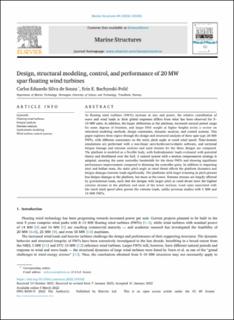| dc.contributor.author | Silva de Souza, Carlos Eduardo | |
| dc.contributor.author | Bachynski-Polic, Erin Elizabeth | |
| dc.date.accessioned | 2022-03-23T14:08:16Z | |
| dc.date.available | 2022-03-23T14:08:16Z | |
| dc.date.created | 2022-03-07T15:27:04Z | |
| dc.date.issued | 2022 | |
| dc.identifier.issn | 0951-8339 | |
| dc.identifier.uri | https://hdl.handle.net/11250/2987135 | |
| dc.description.abstract | As floating wind turbines (FWTs) increase in size and power, the relative contribution of wave and wind loads to their global responses differs from what has been observed for 5–10 MW units. In addition, the larger deflections at the platform, increased natural period range for some degrees of freedom, and larger RNA weight at higher heights invite a review on structural modeling methods, design constraints, dynamic analysis, and control systems. This paper explores these topics through the design and structural analysis of three spar-type 20 MW FWTs, with different constraints on the static pitch angle at rated wind speed. Time-domain simulations are performed with a non-linear aero-hydro-servo-elastic software, and sectional fatigue damage and extreme motions and axial stresses for the three designs are compared. The platform is modeled as a flexible body, with hydrodynamic loads evaluated with potential theory and distributed over the hull. A control system with a motion compensation strategy is adopted, ensuring the same controller bandwidth for the three FWTs and showing significant performance improvements compared to detuning the controller gains. In addition to impacting steel and ballast mass, the static pitch angle at rated thrust affects the platform dynamics and fatigue damage/extreme loads significantly. The platforms with larger restoring in pitch present less fatigue damage at the platform, but more at the tower. Extreme stresses are largely affected by gravitational loads, such that the designs with larger pitch at rated thrust have the highest extreme stresses at the platform and most of the tower sections. Load cases associated with the rated wind speed often govern the extreme loads, unlike previous studies with 5 MW and 10 MW FWTs. | en_US |
| dc.language.iso | eng | en_US |
| dc.publisher | Elsevier | en_US |
| dc.rights | Navngivelse 4.0 Internasjonal | * |
| dc.rights.uri | http://creativecommons.org/licenses/by/4.0/deed.no | * |
| dc.title | Design, structural modeling, control, and performance of 20 MW spar floating wind turbines | en_US |
| dc.type | Journal article | en_US |
| dc.type | Peer reviewed | en_US |
| dc.description.version | publishedVersion | en_US |
| dc.source.journal | Marine Structures | en_US |
| dc.identifier.doi | 10.1016/j.marstruc.2022.103182 | |
| dc.identifier.cristin | 2008108 | |
| dc.relation.project | Norges forskningsråd: 223254 | en_US |
| dc.relation.project | Norges forskningsråd: 309281 | en_US |
| cristin.ispublished | true | |
| cristin.fulltext | original | |
| cristin.fulltext | original | |
| cristin.qualitycode | 2 | |

